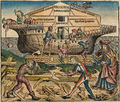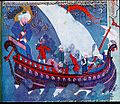Noah's Ark facts for kids
Noah's Ark, according to the Book of Genesis in the Bible, was a very large ship. God told Noah to build it to save himself, his family, and many kinds of animals. This was because God was going to send a huge flood to cover the whole Earth. The Bible says the ark landed on Mount Ararat, which is in modern-day Turkey.
The Bible describes the ark as being 300 ells long, 50 ells wide, and 30 ells high. This means it was about 155 meters (509 feet) long, 26 meters (85 feet) wide, and 15.5 meters (51 feet) high. It would have been about half the size of a large modern ship like the RMS Queen Elizabeth 2. It would have weighed about the same as the RMS Titanic.
Many people have claimed to see the ark over the years. However, there is no proven physical evidence that the ark is still on Mount Ararat today.
Contents
Building the Ark
What was the Ark made of?
The Bible says the ark was made from "gopherwood." No one is completely sure what gopherwood was. Some people think it might have been cypress wood. Cypress trees were often used for building ships in the Middle East because their wood is strong and comes from large trees.
How big was a cubit?
The ark's size was given in cubits: 300 cubits long, 50 cubits wide, and 30 cubits high. For a long time, people didn't know exactly how long a cubit was. In the late 19th century, archaeologists found a tunnel in Jerusalem. This tunnel was built around 700 B.C. by King Hezekiah. An old writing at the entrance said the tunnel was 1200 cubits long. When archaeologists measured the tunnel, they found it was 1800 feet (about 549 meters) long. From this, they figured out that the Hebrew cubit, at least back then, was about 20.4 inches (51.8 centimeters).
How the Ark floated
The ark's shape and size were perfect for floating steadily on water. It wasn't designed to move quickly, but to stay stable. Many modern cargo ships are built with a similar shape to Noah's ark because this design helps them stay very steady in the water.
After Noah built the ark with gopherwood, he had to make it waterproof. The Bible says God told Noah to cover the ark inside and out with "pitch." Pitch is a sticky, waterproof material, like tar, that would have sealed the wood and kept water out.
Building the ark probably took Noah a long time. Based on the ages of Noah and his sons when the flood began, it might have taken him about 55 to 75 years to finish the project.
Thinking about the Ark
Early scientific ideas
During the Renaissance period, people started to think about the Ark story in new ways. They still believed the story was true, but they also wondered about the practical details. For example, in the 15th century, a scholar named Alfonso Tostada wrote about how Noah might have gotten rid of animal waste or kept fresh air inside the ark. Later, in the 16th century, Johannes Buteo calculated the ark's inside space. He even thought about room for Noah's grinding mills and ovens.
Animals spreading out
By the 17th century, explorers had discovered the Americas. This brought up new questions about the Ark. If all animals came from one place after the flood, how did they spread across the continents? People thought that humans might have taken animals with them after the Tower of Babel story. But some things seemed strange. For example, Sir Thomas Browne wondered in 1646 why North America had rattlesnakes but no horses.
Scientists like Athanasius Kircher (c.1601–80) started to study the Ark story more closely. They tried to match the Bible's account with what they knew about natural history. This led to new ideas about how plants and animals are spread around the world, a field now called biogeography. They thought that Mount Ararat might have had different climate zones. As the climate changed, animals would move to new areas that suited them, spreading across the globe.
Too many species?
Over time, more and more animal species were discovered. For earlier natural historians, it wasn't hard to imagine all known animals fitting in the Ark. But by the time John Ray (1627–1705) was working, many more species had been found. It became harder for natural historians to believe that all animal diversity could fit on the Ark. By 1700, fewer scientists believed in a literal interpretation of the Noah's Ark story.
Full-size replica
In 2011, a full-size copy of Noah's ark was built in Dordrecht, a city in the Netherlands.
Images for kids
-
Noah's Ark (1846), by the American folk painter Edward Hicks.
-
The Subsiding of the Waters of the Deluge (1829), a painting by the American painter Thomas Cole.
-
The Ark Encounter theme park.
See also
 In Spanish: Arca de Noé para niños
In Spanish: Arca de Noé para niños










